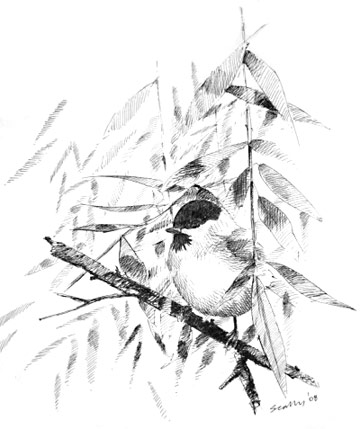
Willow Tit © Ray Scally
The Mersey valley is now one of the national strongholds for Willow Tit, such has been the extent of their rapid decline. From being present in 40% of Cheshire and Wirral tetrads twenty years ago, in this survey it was found in just 7%, a drop from 270 tetrads to 49. The ‘change’ map shows that the decline has taken place across Cheshire, and the species now has only a toe-hold on the Wirral, but they were found in a few new tetrads along the Mersey valley.
The Willow Tit national population dropped during the 1970s but was steady during the period of our First Atlas. From 1987, however, it has been in inexorable decline, falling by 77% in 18 years since then and leading to red status for the species on the list of birds of conservation concern. Detailed analysis shows that the drop has not been uniform and the numbers are stable in their preferred wet habitats (Siriwardena 2004). Farmland is now only rarely occupied, and Willow Tits fare badly in dry woodland. These conclusions are from the nationwide annual censuses, and the recorded habitat codes in this Atlas survey illustrate the species’ preference for waterlogged (carr) broadleaved woodland (10 tetrads) and scrub (14 tetrads), with 11 records from broadleaved woodland, five from mixed woodland and six others.
The causes of decline have been suggested to be competition with other tit species, increasing nest predation by Great Spotted Woodpeckers, and deterioration in the quality of woodland as feeding habitat for Willow Tits through canopy closure and increased browsing by deer (Fuller et al 2005). However, neither of the first two hypotheses stands up to scrutiny in the breeding season for Willow Tits in woodland and their decline is more likely to be caused by winter factors (Siriwardena 2004). At all seasons they differ from the common tits by feeding almost exclusively in the shrub layer, not using the tree canopy or finding food on the ground, and the problem may lie in unknown, but deleterious, changes in their shrubby food sources. There are relatively few deer in Cheshire and they have not wrought mass habitat destruction here as they have in other counties, so the cause must lie elsewhere.
Willow Tit is the only species, other than woodpeckers, that excavates its own nest holes, but live trees are too tough for them and they can only nest in rotting wood. Sometimes they do all of the work, only to be evicted by Blue or Great Tits, but other observations show that some Willow Tits can successfully defend their nest-holes. Nests are usually low down, typically 1 or 2 m above ground, on average containing 5 noisy chicks that often attract an observers’ attention – and presumably that of predators as well. However, nests were found in only four tetrads, with adults carrying food for their chicks – almost invariably caterpillars – in five and recently fledged young were observed in a further six. Where the species is common, it is not difficult to prove breeding, but odd pairs can be quite quiet. The song, a sweet warbling, is seldom heard but their nasal call is distinctive and far-carrying. Although their territories can be large – up to 9 ha – Willow Tits do not move far during the year, and the ‘possible’ breeding records are likely to refer to birds resident in the tetrad.
From being a widespread bird, with a Cheshire and Wirral population estimated at 350-400 pairs twenty years ago, the current county population is unlikely to be much above 50 pairs, with perhaps one quarter of them at Woolston.
Sponsored by Nantwich Natural History Society

